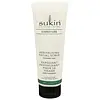What's inside
What's inside
 Key Ingredients
Key Ingredients

 Benefits
Benefits

 Concerns
Concerns

 Ingredients Side-by-side
Ingredients Side-by-side

Water
Skin ConditioningAloe Barbadensis Leaf Juice
Skin ConditioningSesamum Indicum Seed Oil
EmollientCetearyl Alcohol
EmollientCetyl Alcohol
EmollientCeteareth-20
CleansingBambusa Arundinacea Stem Extract
Skin ConditioningJuglans Regia Shell Powder
AbrasiveGlycerin
HumectantSimmondsia Chinensis Seed Oil
EmollientRosa Canina Fruit Oil
EmollientChamomilla Recutita Flower Extract
MaskingArctium Lappa Root Extract
Skin ConditioningTocopherol
AntioxidantCitrus Tangerina Peel Oil
MaskingCitrus Nobilis Peel Oil
MaskingLavandula Angustifolia Oil
MaskingVanillin
MaskingVanilla Planifolia Fruit Extract
Skin ConditioningCitric Acid
BufferingPhenoxyethanol
PreservativeBenzyl Alcohol
PerfumingLinalool
PerfumingLimonene
PerfumingWater, Aloe Barbadensis Leaf Juice, Sesamum Indicum Seed Oil, Cetearyl Alcohol, Cetyl Alcohol, Ceteareth-20, Bambusa Arundinacea Stem Extract, Juglans Regia Shell Powder, Glycerin, Simmondsia Chinensis Seed Oil, Rosa Canina Fruit Oil, Chamomilla Recutita Flower Extract, Arctium Lappa Root Extract, Tocopherol, Citrus Tangerina Peel Oil, Citrus Nobilis Peel Oil, Lavandula Angustifolia Oil, Vanillin, Vanilla Planifolia Fruit Extract, Citric Acid, Phenoxyethanol, Benzyl Alcohol, Linalool, Limonene
Water
Skin ConditioningQuartz
AbrasiveGlyceryl Stearate Se
EmulsifyingRosa Canina Fruit Oil
EmollientOenothera Biennis Oil
EmollientGlycerin
HumectantC12-16 Alcohols
EmollientLactic Acid
BufferingSodium Cocoyl Isethionate
CleansingPhenoxyethanol
PreservativeXanthan Gum
EmulsifyingOrmenis Multicaulis Oil
MaskingSodium Hydroxide
BufferingCoconut Acid
CleansingSclerotium Gum
Emulsion StabilisingLecithin
EmollientPullulan
Lavandula Angustifolia Oil
MaskingRosmarinus Officinalis Leaf Oil
MaskingDisodium EDTA
Sodium Isethionate
CleansingSilica
AbrasiveLimonene
PerfumingLinalool
PerfumingWater, Quartz, Glyceryl Stearate Se, Rosa Canina Fruit Oil, Oenothera Biennis Oil, Glycerin, C12-16 Alcohols, Lactic Acid, Sodium Cocoyl Isethionate, Phenoxyethanol, Xanthan Gum, Ormenis Multicaulis Oil, Sodium Hydroxide, Coconut Acid, Sclerotium Gum, Lecithin, Pullulan, Lavandula Angustifolia Oil, Rosmarinus Officinalis Leaf Oil, Disodium EDTA, Sodium Isethionate, Silica, Limonene, Linalool
Ingredients Explained
These ingredients are found in both products.
Ingredients higher up in an ingredient list are typically present in a larger amount.
Glycerin is already naturally found in your skin. It helps moisturize and protect your skin.
A study from 2016 found glycerin to be more effective as a humectant than AHAs and hyaluronic acid.
As a humectant, it helps the skin stay hydrated by pulling moisture to your skin. The low molecular weight of glycerin allows it to pull moisture into the deeper layers of your skin.
Hydrated skin improves your skin barrier; Your skin barrier helps protect against irritants and bacteria.
Glycerin has also been found to have antimicrobial and antiviral properties. Due to these properties, glycerin is often used in wound and burn treatments.
In cosmetics, glycerin is usually derived from plants such as soybean or palm. However, it can also be sourced from animals, such as tallow or animal fat.
This ingredient is organic, colorless, odorless, and non-toxic.
Glycerin is the name for this ingredient in American English. British English uses Glycerol/Glycerine.
Learn more about GlycerinLavandula Angustifolia Oil is more commonly known as lavender essential oil. It is considered a fragrancing ingredient.
Lavender imparts a famous scent. While the smell is lovely, this ingredient and may sensitize skin in topical products. This is because about 85% of the oil is made up of linalool and linalyl acetate.
When exposed to air, these two compounds become strong allergens. This ingredient exhibits cytotoxicity at low concentrations; amounts of 0.25% have been shown to damage skin cells.
A study from Japan found this ingredient caused lavender sensitivity after widespread exposure.
Lavender essential oil has some antimicrobial, antibacterial, and anti-inflammatory properties. However, the cons of this ingredient may outweight the pros.
More research is needed to confirm lavender essential oil's effects when used in aromatherapy.
Lavandula Angustifolia is known as the English Lavender and famous for creating purple fields in Provence, France.
Learn more about Lavandula Angustifolia OilLimonene is a fragrance that adds scent and taste to a formulation.
It's found in the peel oil of citrus fruits and other plants such as lavender and eucalyptus. The scent of limonene is generally described as "sweet citrus".
Limonene acts as an antioxidant, meaning it helps neutralize free radicals.
When exposed to air, oxidized limonene may sensitize the skin. Because of this, limonene is often avoided by people with sensitive skin.
The term 'fragrance' is not regulated in many countries. In many cases, it is up to the brand to define this term. For instance, many brands choose to label themselves as "fragrance-free" because they are not using synthetic fragrances. However, their products may still contain ingredients such as essential oils that are considered a fragrance.
Learn more about LimoneneLinalool is a fragrance and helps add scent to products. It's derived from common plants such as cinnamon, mint, citrus, and lavender.
Like Limonene, this ingredient oxidizes when exposed to air. Oxidized linalool can cause allergies and skin sensitivity.
This ingredient has a scent that is floral, spicy tropical, and citrus-like.
Learn more about LinaloolPhenoxyethanol is a preservative that has germicide, antimicrobial, and aromatic properties. Studies show that phenoxyethanol can prevent microbial growth. By itself, it has a scent that is similar to that of a rose.
It's often used in formulations along with Caprylyl Glycol to preserve the shelf life of products.
Rosehip Oil is a non-fragrant plant oil. Rosehips are a fruit from a rose bush and are edible. This oil has skin conditioning and hydrating properties.
Rosehip contains Vitamin C, Vitamin E, fatty acids and linolenic acids. These nourish your skin barrier. Having hydrated skin may help reduce the appearance of fine-lines and wrinkles.
Another great component of Rosehip Oil is Vitamin A, or retinol. Vitamin A encourages your skin to create more collagen.
Rosehip oil may help with reducing pigmentation. The lycopene and beta-carotene have skin-lightening properties. However, more studies are needed to confirm this.
Learn more about Rosa Canina Fruit OilWater. It's the most common cosmetic ingredient of all. You'll usually see it at the top of ingredient lists, meaning that it makes up the largest part of the product.
So why is it so popular? Water most often acts as a solvent - this means that it helps dissolve other ingredients into the formulation.
You'll also recognize water as that liquid we all need to stay alive. If you see this, drink a glass of water. Stay hydrated!
Learn more about Water